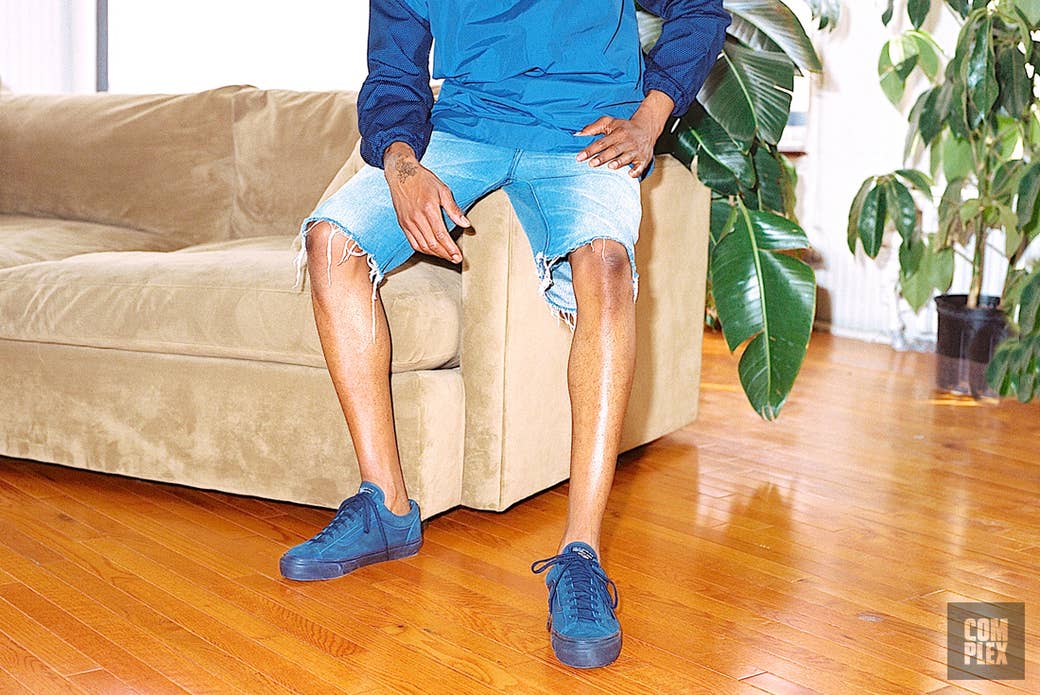
Rapper Allan Kingdom is standing outside the Grammy Awards for his first major red carpet appearance. It’s February 16, 2016, and he’s been nominated for two awards for his collaboration with Kanye West, “All Day.” Publicists and members of the press are milling around nearby, while paparazzi, cameras flashing, call out the names of other nominees and presenters, many of whom are angling for a spot on a best dressed list or a shared photo on Instagram. Pharrell is wearing a Chanel jacket; A$AP Rocky is in head-to-toe Gucci. Kingdom isn’t as flashy as those two, but is leaving a mark in his own way; the 21-year-old rapper is dressed in a light brown suit from Joseph Abboud with a Avion Clothiers white button down shirt underneath. And on his feet are something a little more casual: A pair of all-white Vans Sk8-Hi sneakers.
“I didn’t want to wear dress shoes to the Grammys,” he says today. “I wanted to wear sneakers, something chill that described my personality.”
Allan, who grew up in Minnesota, didn’t skate growing up, and he doesn’t now. But, like so many other well-dressed guys, he still wears Vans. He remembers first hearing The Pack’s 2009 song “Vans” in junior high and buying a pair of colored checkerboard Sk8-His. “All my friends started wearing them,” he says. “It was cool.” Now, he always has a pair in his closet. “I just feel like there’s so many purposes to it. You could stunt. You could look like you don’t care. I think it’s become more than a skate shoe.”
Vans, which celebrates its 50th anniversary today, has been dubbed the world’s number one skateboard shoe. But it isn’t just a skate shoe for skaters anymore.

On March 16, 1966, Paul Van Doren, along with his brother Jim, Serge D’Elia, and Gordon Lee, founded the first Van Doren Rubber Company in Anaheim, Calif. By the ‘70s, the Vans Authentic, with its rugged upper and vulcanized outsole that provided suitable grip on boards, became the shoe of choice for skaters, including the Zephyr team, also known as the Z-Boys, a group of skaters from Venice Beach, Calif. who imbued skating with the reckless spirit with which it became synonymous. “The [Z-Boys’] popularity blew Vans up with everybody now knowing Vans as this skate shoe brand,” says Rian Pozzebon, Vans’ director of footwear color and trend. “That’s the first thing that put Vans on the map globally, and that showcased what the brand stood for.”
Vans embraced its fanbase. In 1976, the brand released its second model, the Era, which is considered to be the first signature skateboarding shoe. The Era, designed by legendary skaters and Z-Boys members Tony Alva and Stacy Peralta, came to fruition after the need for a more padded, skate-specific version of the Authentic. In the years that followed, Vans sponsored skateboarders, skate events, and let guys like Steve Caballero design his own signature skate shoe.
Vans is a skateboarding company, no doubt, but its evolution kicked into high gear in the '80s, when they began creating shoes for a number of sports: Baseball, basketball, wrestling, and even skydiving. During that period, they also cemented their first fashion collaboration. “In a very underground way, we’ve always been in the fashion business,” says Steve Mills, Vans’ vice president - global product marketing - footwear classics. In the early ‘80s, Vans gave European brand WP Lavori their own logo shoe boxes, their own private label heel tabs, and offered them maximum freedom to order large scale customs and prints exclusive to Europe. Later, WP Lavori acquired their own license for exclusive Vans apparel all made in Italy. Vans also seeded slip-ons to be used in runway shows during fashion week for brands like Rebecca Taylor, Luella Bartley, and Trovata. “In a weird kind of way, we’ve always been there,” notes Mills.

In 1996, Vans kicked off a long-term partnership with Supreme—one of its most hyped streetwear collaborations. “When we started [the Syndicate collection], it started to resonate with the ideas, morales, and standards that Supreme had in place,” says Pozzebon, who worked on the collaboration with Supreme founder James Jebbia. The first Old Skool designed by Vans and Supreme didn’t sell out immediately, but, Pozzebon says, working with Supreme helped popularize Vans. “At that time, I think people’s awareness of Vans was actually pretty low. If you go back to when we started working with Supreme, streetwear was nowhere near what the volume is today. Vans was significantly smaller than what it is today,” he says. “[Supreme] was key in helping us grow and bring in more attention to the history of Vans.”
The fashion collaborations continued. In July 2003, Vans launched its Vault collections, which offered premium collaborations and footwear capsules. It began by updating simple canvas silhouettes with luxe materials. But soon, the fashion industry took notice, and that same year Vans released collaborations with Rebecca Taylor and Luella Bartley. Two years later, Vault inked a three-year partnership with Marc Jacobs, which Mills credits as being the fashion collaboration that helped alter the way Vans was seen in the fashion industry.
“At that point, from just a press and media standpoint, we had never been written about in Women’s Wear Daily, but we were front page. That was a big story,” Pozzebon explains. “I don’t think it just made people take notice in the fashion industry. I think [Marc Jacobs] gave us a whole new spin in regards to how we were perceived by artists and musicians. Anyone in the creative field, I think, looked at us in a different way. When we were working with Marc, he was still the creative director of Louis Vuitton. He was the guy in the industry, he was the kingpin, he was at the top of the mountain. So, for him to go and work with a small skate brand in California over, say, a big Nike brand or Converse brand or an older, established athletic brand, I think it was pretty eye-opening for a lot of people in that industry.”

Vans never pursued anyone in the fashion industry, says Mills; brands approached them. When asked why brands wanted to work with Vans, Pozzebon points to the sneaker designs. “It was the simplicity of the designs of our sneakers. There’s a lot you can do with them,” he says. “Vans came out originally as a brand where you can customize your own shoes and color. You could bring in textiles that you had to make your own shoes.” He refers to the checkerboard Slip-On released in the late ‘70s that was famously developed after Steve Van Doren, son of Vans founder Paul Van Doren and Vans’ vice president of events and promotions, noticed kids coloring the side profile of the shoe, where the white rubber was, in a checkerboard pattern. “[Customizing] 100% played a role. It was just that natural piece. It just evolved into that, especially with people seeing Vans as this canvas you can create new things with.”
The designers and brands interviewed for this piece say they worked with Vans because it was familiar. “I skated when I was younger and have always been a big fan,” says Daiki Suziki, founder of Engineered Garments, which has produced the Authentics and the Slip-Ons, the latter of which feature one foot in suede and the other in leather, inspired by the way kids used to swap one shoe with friends. Next week, Engineered Garments will release another Slip-On and its take on the Sk8-Hi.
Safa Taghizadeh, men’s designer at Steven Alan, which has also produced exclusive sneakers with Vans, agrees with Suzuki. He says Steven Alan used the Sk8-Hi and Style 36 because it was nostalgic. “That was probably a me thing. I grew up skateboarding, so they were the shoes I always wore. I think they represent a certain demographic and speak to a certain demographic.” Steven Alan has added the checkerboard Slip-On to its next collaboration, which is slated for a June 2016 release.
For Opening Ceremony, it was about working with the pioneers. “We’ve always been fans of the brand,” says Jesse Hudnutt, buyer at Opening Ceremony. “Their silhouettes are so classic at this point, and so heavily referenced, that we wanted to work with the guys who started it all on our own interpretations of these familiar shapes.”
Fashion collaborations exposed Vans to people who weren’t familiar with skate culture. “I’m sure there’s many skateboard purists that would say that’s ‘bad’ for skateboarding and ‘bad’ for Vans, because any subculture has kind of these protectors,” says Lawrence Schlossman, brand director at Grailed and former Four Pins editor. “But at the end of the day, the fashion collaborations have definitely made Vans relevant in a marketplace and industry where maybe they weren’t viewed with as much respect as they are now.”
Vans didn’t disclose sales figures, but Mills maintains that the fashion collaborations have been successful from a financial point of view, as well. “It’s one of our four pillars,” he says. “I think that we will to continue...we’re gonna be incredibly open-minded towards the gamut of people that are involved in the fashion industry.” Vans has now collaborated with the likes of Pendleton, Kenzo, Diemme, WTAPS, Comme des Garçons SHIRT, Stüssy, Gosha Rubchinskiy, Dime, Carhartt, Barneys, and The North Face.
But Vans’ success in fashion goes beyond these collaborations. Today, the industry is heavily influenced by the skate culture. At Dover Street Market, brands like Bianca Chandon, Palace, and Supreme hang alongside high-fashion labels like Prada and Gucci. Further cementing the trend, in July 2015, Dover Street Market opened a new space online and at its London store dedicated to graphic T-shirts mostly from skate brands, such as Brain Dead, Quartersnacks, and Thrasher, whose currently ubiquitous T-shirts and hoodies are impossible to miss on both men and women in the fashion industry. DSM opened a similar physical space at its New York location this past January.
Last year, Louis Vuitton chose pro-skater and Bianca Chandon designer Alex Olsen to promote its new leather accessories. Russian skate brand Gosha Rubchinskiy has been worn by everyone from A$AP Rocky to 2 Chainz. (Yes, 2 Chainz.)

That same influence ushered the return of Vans’ classic silhouettes, including the Old Skools—one of the most popular styles today. Justin Bieber, Big Sean, Nick Young, and Kanye have all been spotted in Vans, and you can see the same sneakers on the feet of fashion industry insiders like Virgil Abloh, A$AP Nast, and Ian Connor. Regular guys are wearing them, too. “These [celebrities and influences] are wearing Vans and the kids who look up to those dudes and respect them, whether just purely based on the fashion aspect or based on the other stuff that they do, that’s gonna contribute to the popularity that we’re seeing right now,” says Schlossman. According to him, it also helps that Vans are affordable and accessible. “If I live in Ohio and there’s a mall in my town, I can get Vans at Journeys or Zumiez. I don’t need to be in New York to hit up some super exclusive boutique to get an item or wait for them to drop online. What we’re seeing in a cool guy’s Instagram photo are not some super exclusive collab. They’re just straight up normal Old Skools that you can buy anywhere, anytime, no matter who you are.”
Mills insists that Vans won’t abandon its original fanbase of skateboarders. “We are, first and foremost, a skate brand and that is front of mind in almost anything we do,” he says, adding that their top sellers are still the classics and not any fashion collaboration. But it’s hard to ignore that, as former Details style director Eugene Tong told Business of Fashion, what “started as the ultimate representation of West Coast skate and surf culture” has “morphed into a mainstream casual sneaker option.”
“[Vans] has managed to remain authentic and yet become a fashion staple,” adds Steven Alan’s Safa Taghizadeh. “It’s like a can of Coke—it’s great for everybody.”

Styled by Mitsu Tsuchiya

